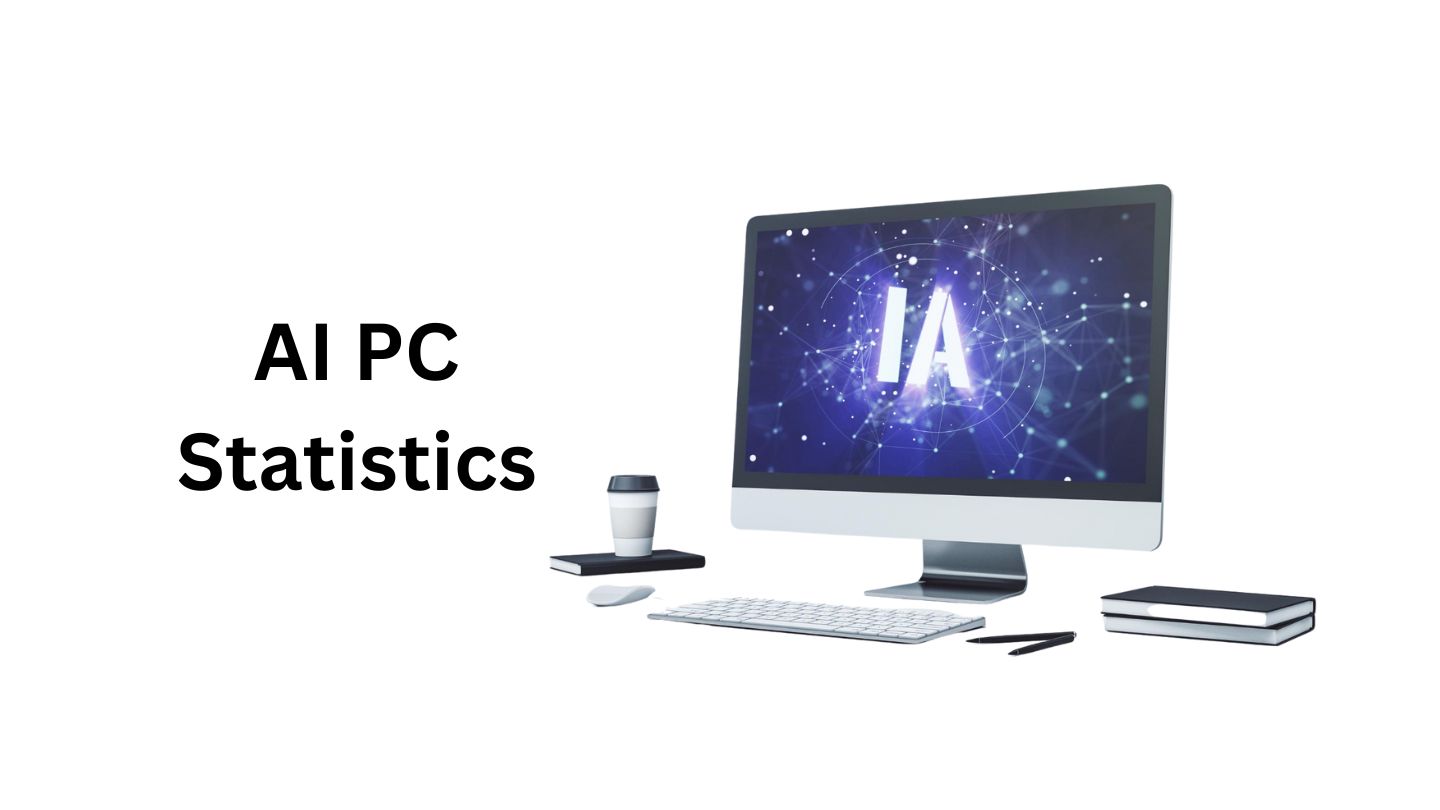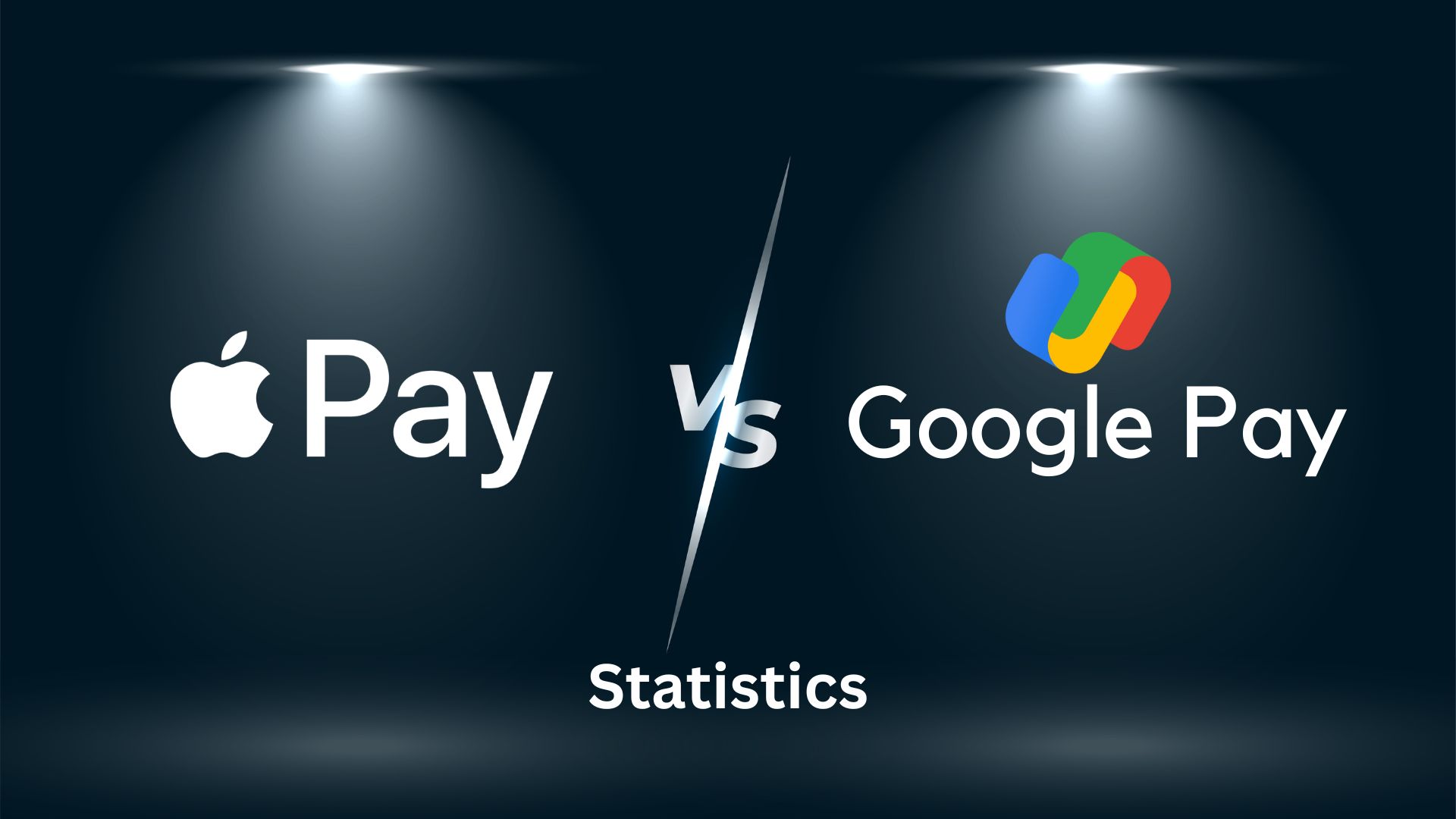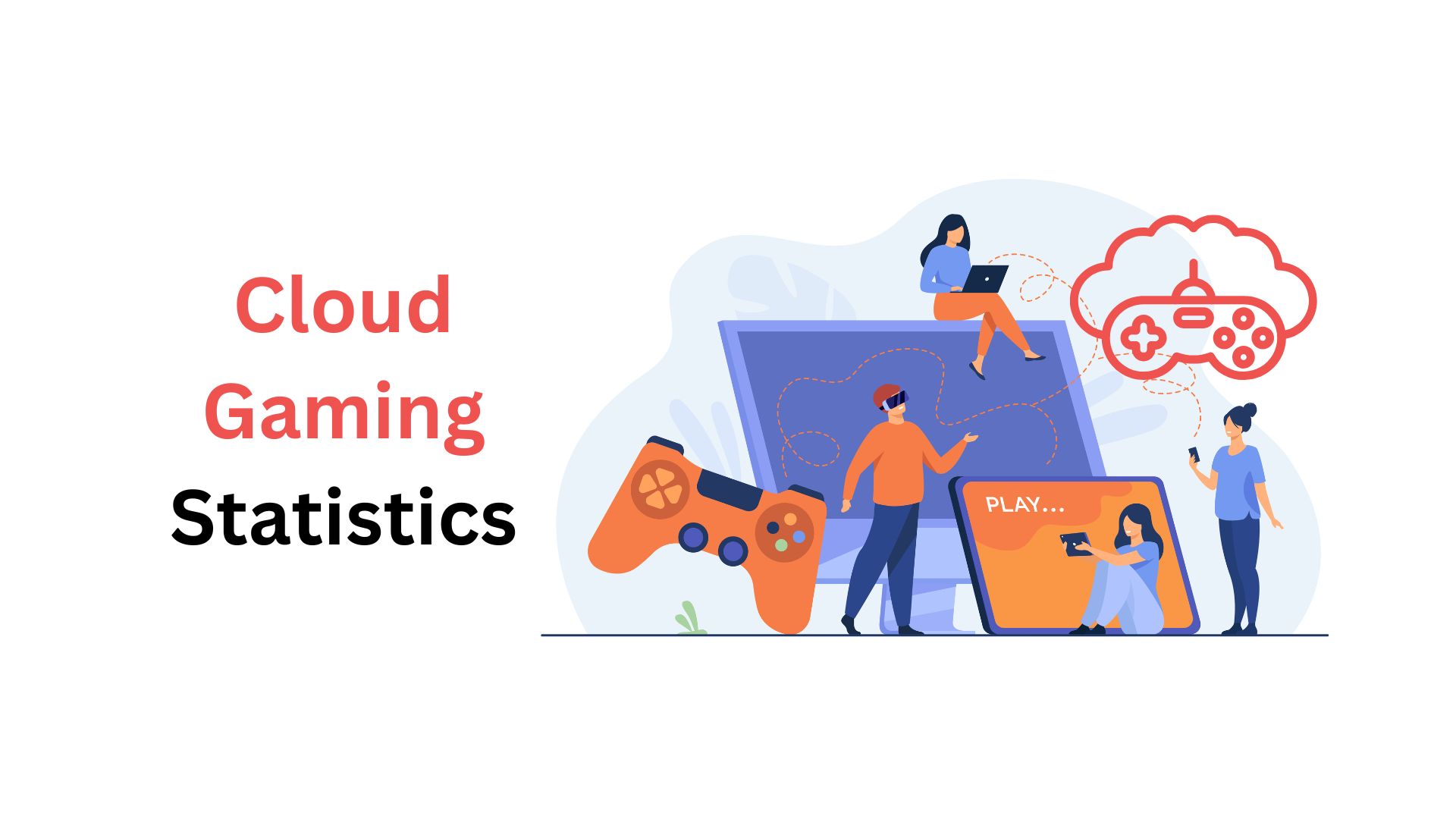Neuromorphic Computing Statistics By Market Size, Usage and Facts (2025)
Updated · Nov 27, 2025

Table of Contents
- Introduction
- Editor’s Choice
- Neuromorphic Computing Market Size
- Neuromorphic Sensing and Computing Forecast by End-Use
- Neuromorphic Computing Market Size Statistics by Components
- US Neuromorphic Computing Market Size
- Neuromorphic Computing Market Share by Region
- By End-Users
- Neuromorphic Computing Country Statistics
- Capacities of Selected Recent Neuromorphic Systems
- Distribution of Brain-Inspired Computing Approaches
- Conclusion
Introduction
Neuromorphic Computing Statistics: Neuromorphic Computing is a part of computer science and engineering that builds computer models based on the human brain. It creates specialised hardware and software that work like networks of brain cells, enabling machines to process information more efficiently and in a more human-like, adaptable way for tasks such as learning. Rather than using simple step-by-step rules, neuromorphic computers rely on many units working together, similar to brain cells.
This article uses current statistical analysis across several insights to explore trends in research, new hardware designs, and system performance, showing how rapidly the field is growing and why it matters for future AI and smart devices.
Editor’s Choice
- According to Market.Us, the global Neuromorphic Computing market is expected to account for around USD 7.8 billion in revenue by 2025.
- Precedence Research reports that North America led the neuromorphic computing market in 2024 with a 37% share.
- Meanwhile, the Asia Pacific is forecast to expand at a 22.71% CAGR from 2025 to 2034.
- In 2024, hardware represented 80% of components, and image processing applications accounted for 46% of global market demand.
- In 2025, the Neuromorphic Computing market is projected to reach a total revenue of USD 7.83 billion, with hardware generating USD 5.1 billion.
- By 2025, the U.S. Neuromorphic Computing market is expected to reach USD 2.13 billion, up from USD 1.76 billion in 2024.
- As of 2024, the neuromorphic computing market spans many industries, with consumer electronics leading at 48% due to smart-device chip adoption.
- Recent systems ODIN and µBrain each use 256 neurons and 64K synapses per core on one board chip.
- Digital hardware uses several designs, such as slice-based chips like Microdevices MD-1220a, NeuraLogix NLX-420a, and Philips Lneuro-1.
- Neuromorphic computing holds the largest share of studied approaches, accounting for 29%.
Neuromorphic Computing Market Size

(Source: market.us)
- The global neuromorphic computing market was valued at USD 5.1 billion in 2023 and is expected to reach USD 29.2 billion by 2032, supported by a steady 22% CAGR during 2023 to 2032.
- Hardware dominated the component segment in 2022, capturing 65.56% of total revenue due to rising demand for neuromorphic chips used in next-generation processing systems.
- Edge computing led the deployment segment in 2022 with 67% revenue share, reflecting the increasing adoption of low-latency and on-device intelligence solutions.
- Image processing held the leading position within applications in 2022 with 47% share, driven by wider use across vision systems and intelligent sensing technologies.
- Consumer electronics is expected to remain the dominant end-use category, accounting for 57% share over the forecast period as device manufacturers integrate advanced neural processing capabilities.
- North America is projected to maintain leadership in the neuromorphic computing market with 40.5% share throughout the projected timeframe, supported by strong R&D activity and early technology adoption.
Neuromorphic Sensing and Computing Forecast by End-Use
| Year | Total Market Size (USD million) |
Mobile & Consumer | Automotive & Mobility | Medical | Communication & Infrastructure | Industrial | Defense & Aerospace |
| 2024 | 28 | 83% | 0% | 0% | 10% | 7% | 0% |
| 2029 | 822 | 48% | 7% | 1% | 14% | 14% | 2% |
| 2034 | 8,352 | 46% | 16% | 1% | 15% | 15% | <1% |
(Source: medias.yolegroup.com)
- In 2024, the global neuromorphic sensing and computing market reached USD 28 million, and the Mobile and Consumer segment accounted for 83% of total demand while Communication and Infrastructure held 10% and the Industrial segment contributed 7%, with negligible adoption in Automotive and Mobility, Medical, and Defense and Aerospace.
- In 2029, the market expanded to USD 822 million, and the Mobile and Consumer segment represented 48%, followed by Industrial and Communication and Infrastructure at 14% each, while Automotive and Mobility accounted for 7%, Medical held 1%, and Defense and Aerospace reached 2%.
- By 2034, the market value increased to USD 8,352 million, and Mobile and Consumer maintained 46%, while Automotive and Mobility captured 16% and both Communication and Infrastructure and Industrial stood at 15% each, with Medical at 1% and Defense and Aerospace recording less than 1%.
Neuromorphic Computing Market Size Statistics by Components
- In 2025, the Neuromorphic Computing market is expected to generate total revenue of USD 7.83 billion, with hardware accounting for USD 5.1 billion.
- Moreover, software contributes USD 1.67 billion, and services account for USD 1.06 billion.
| Year | Hardware | Software | Services |
| Revenue (USD billion) | |||
| 2026 | 6.3 | 2.08 | 1.32 |
| 2027 | 7.5 | 2.48 | 1.58 |
| 2028 | 8.6 | 2.82 | 1.8 |
| 2029 | 10.5 | 3.45 | 2.19 |
| 2030 | 12.5 | 4.11 | 2.61 |
| 2031 | 15.2 | 5.01 | 3.18 |
| 2032 | 19 | 6.25 | 3.97 |
- The Neuromorphic Computing market is expected to generate USD 7.83 billion in 2025, and the hardware segment is projected to contribute USD 5.1 billion, reflecting its strong role in system development and deployment.
- The software segment is anticipated to reach USD 1.67 billion in 2025, supported by the rising need for training frameworks and cognitive algorithms across advanced computing environments.
- The services segment is expected to record USD 1.06 billion in 2025, driven by integration support, consulting needs, and ecosystem enablement.
- In 2026, hardware revenue is projected to reach USD 6.3 billion, software is expected to generate USD 2.08 billion, and services are estimated at USD 1.32 billion, reflecting steady adoption across enterprise applications.
- In 2027, hardware revenue is anticipated to rise to USD 7.5 billion, software is expected to reach USD 2.48 billion, and services are projected at USD 1.58 billion, supported by growing interest in neuromorphic models.
- In 2028, hardware is expected to record USD 8.6 billion, software will likely generate USD 2.82 billion, and services are projected to reach USD 1.8 billion, indicating broader scaling across AI workloads.
- In 2029, hardware revenue is forecasted to reach USD 10.5 billion, software is expected at USD 3.45 billion, and services are projected at USD 2.19 billion, driven by increased deployment across edge and autonomous systems.
- In 2030, hardware is anticipated to hit USD 12.5 billion, software is expected to record USD 4.11 billion, and services are projected at USD 2.61 billion, supported by maturing cognitive computing architectures.
- In 2031, hardware is expected to reach USD 15.2 billion, software is projected at USD 5.01 billion, and services are forecasted to generate USD 3.18 billion, reflecting strong enterprise and research adoption.
- In 2032, hardware revenue is anticipated to rise to USD 19 billion, software is expected to generate USD 6.25 billion, and services are projected to reach USD 3.97 billion, highlighting the expansion of neuromorphic systems across large scale commercial applications.

(Source: Precedence Research)
- In 2024, hardware accounted for the largest share of the neuromorphic computing market, at 80%.
- Additionally, the Software and Services component secured 11% and 9% market share, respectively.
US Neuromorphic Computing Market Size
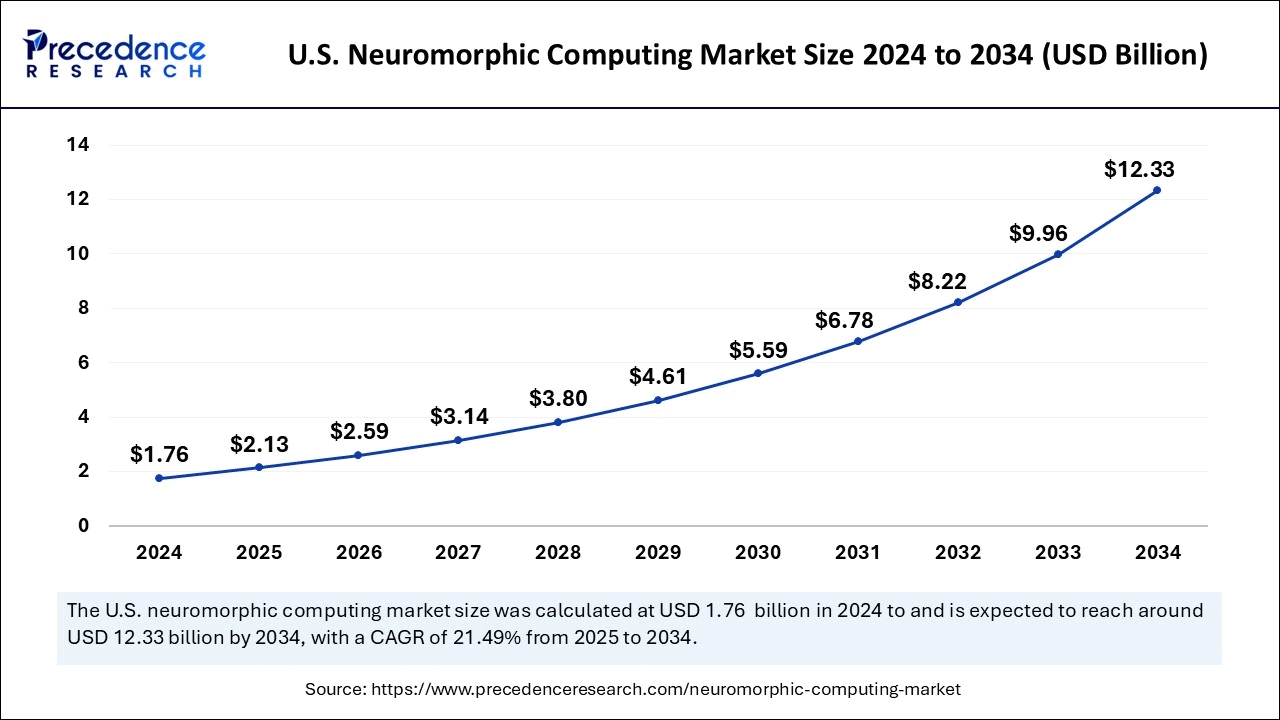
(Source: Precedence Research)
- The U.S. neuromorphic computing market was valued at USD 1.76 billion in 2024, and it is expected to reach USD 12.33 billion by 2034, supported by a CAGR of 21.49% from 2025 to 2034 as shown in the image.
- The market growth reflects a steady rise from USD 2.13 billion in 2025 to USD 2.59 billion in 2026, indicating early acceleration driven by higher adoption of cognitive computing systems.
- The market is projected to reach USD 3.14 billion in 2027 and USD 3.80 billion in 2028 as enterprises expand investments in AI-driven processors and adaptive hardware.
- By 2029, the market size is expected to rise to USD 4.61 billion, followed by USD 5.59 billion in 2030 as neuromorphic chips gain stronger traction in autonomous and embedded intelligence applications.
- In 2031, the market is anticipated to reach USD 6.78 billion, with further growth to USD 8.22 billion in 2032 driven by advancements in ML and deep learning workloads.
- The market is projected to rise to USD 9.96 billion in 2033 as industries adopt more efficient neural architectures for real-time processing.
- By 2034, the market is expected to achieve USD 12.33 billion, reflecting sustained momentum in high-performance, low-power neuromorphic systems.
- North America held the largest share of the global neuromorphic computing market in 2024, supported by early technology adoption and a strong competitive ecosystem.
- Regional growth is influenced by rising utilization of consumer electronics, rapid industrialization, and the expansion of the healthcare sector demanding advanced computational systems.
- Increasing deployment of AI, ML, deep learning, and IoT technologies across enterprises is creating substantial demand for neuromorphic computing solutions throughout North America.
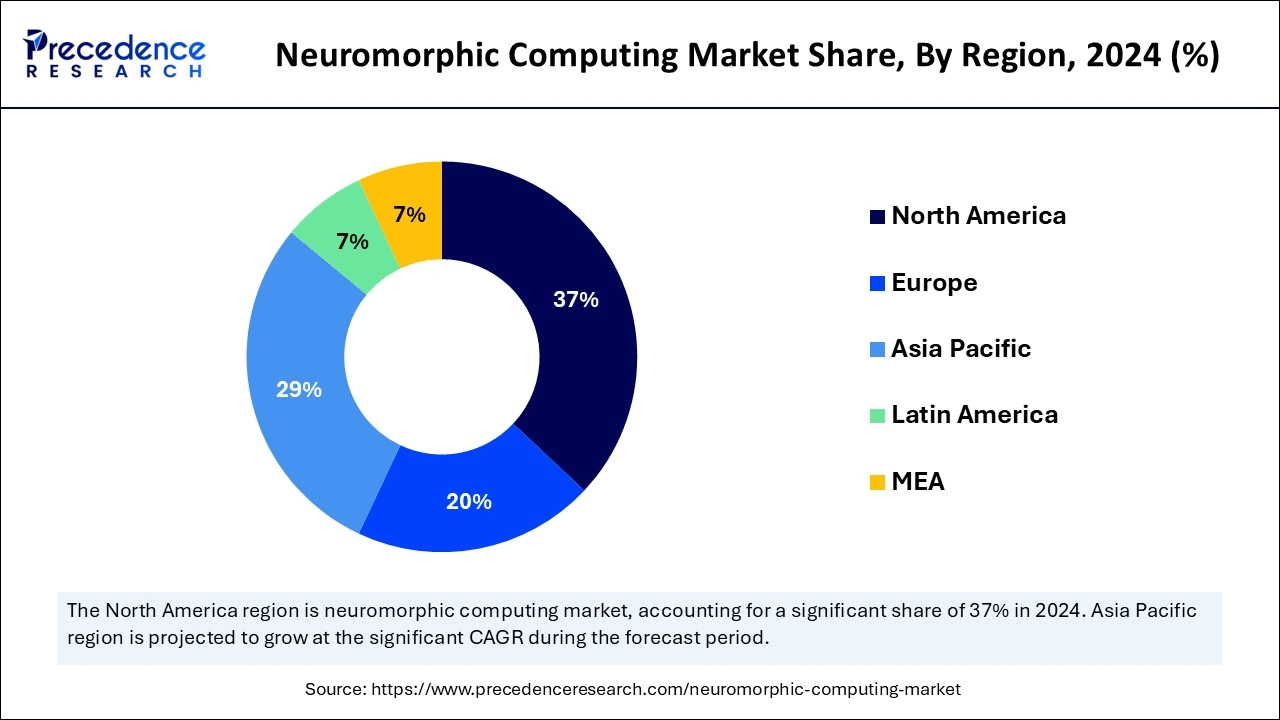
(Source: Precedence Research)
- The image shows that North America accounted for 37% of the neuromorphic computing market share in 2024, reflecting its strong base for early adoption and technology innovation.
- Europe held 20% of the market share in 2024, supported by growing research activities and industrial automation.
- Asia Pacific captured 29% of the market share, showing expanding demand for AI-driven computing architectures across diverse industries.
- Latin America recorded 7% of the market share in 2024, indicating gradual adoption supported by digital transformation initiatives.
- The MEA region also held 7% of the market share, driven by emerging interest in advanced computing solutions across select markets.
- Asia Pacific is expected to record strong growth due to rising deployment of AI, ML, IoT devices, and neural network technologies across manufacturing, electronics, and enterprise sectors.
- Expanding industrialization, government funding, and investments in digital infrastructure are enabling broader access to advanced neuromorphic technologies across Asia Pacific.
- Increasing collaborations among enterprises, governments, and research institutes are strengthening the regional ecosystem for neuromorphic computing.
- India is identified as a major market within the region due to significant government investments in AI, growing R&D activities, and policy support under the Digital India program.
- China remains the leading contributor to the regional market, supported by initiatives such as Made in China and strong investment in AI research and semiconductor development.
- Japan and South Korea are contributing significantly due to advanced AI infrastructure, strong research capabilities, and government support for next-generation computing.
- In September 2024, researchers at the Indian Institute of Science introduced a brain-inspired analog computing platform capable of storing and processing data across 16,500 conductance states within a molecular film, demonstrating progress in neuromorphic innovation.
By End-Users
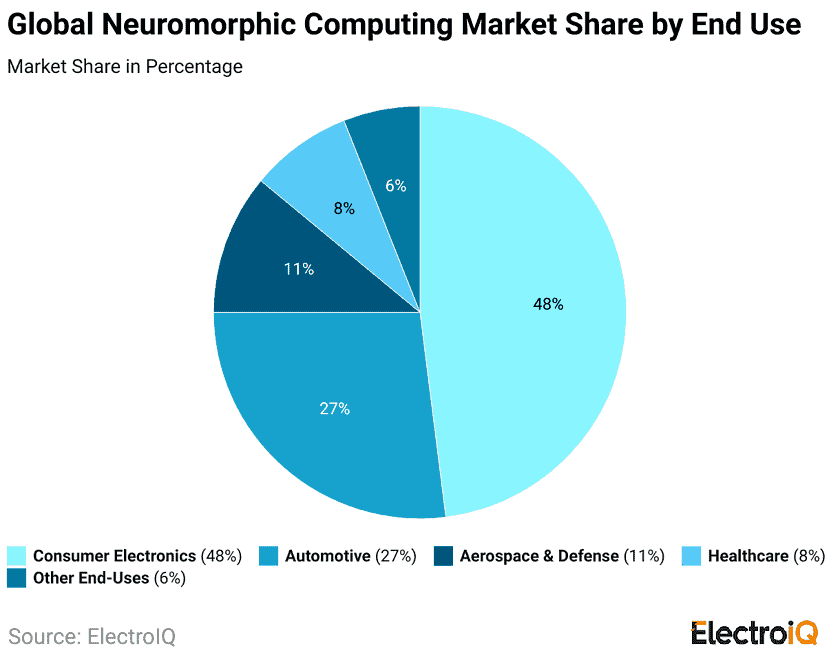
(Reference: scoop.market.us)
- In 2024, consumer electronics were the highest market sfor are in neuromorphic computing, with 48% driven by widespread smart-device chips.
- The automotive sector ranks next with 27%, using neuromorphic computing for self-driving, safety, and infotainment features.
- Aerospace and defense account for 11%, healthcare for 8%, and the remaining 6% is split among smaller sectors.
Neuromorphic Computing Country Statistics
- According to Grand View Research, the U.S. neuromorphic computing market is expected to reach around USD 5,179.8 million by 2030, with a 19.8% CAGR from 2024 to 2030.
Furthermore, other countries’ estimated market analysis is mentioned in the table below:
| Country | Market Size, 2030 (USD million) |
CAGR (From 2024 to 2030) |
| Canada | 1,826.9 | 20.1% |
| Mexico | 388.7 | 15.2% |
| United Kingdom | 847.6 | 18.9% |
| Germany | 975.4 | 17.3% |
| France | 650 | 19.6% |
| China | 2,126.7 | 20.1% |
| Japan | 1,140.3 | 21.1% |
| India | 923.7 | 23.8% |
| Brazil | 472.8 | 19.6% |
Capacities of Selected Recent Neuromorphic Systems
- Recent neuromorphic systems such as ODIN and µBrain are designed with 256 neurons and 64K synapses per core on a single chip, reflecting a compact architecture focused on energy-efficient computation.
- The DYNAPs platform operates with 256 neurons and 16K synapses per core, showing a lower synaptic capacity that influences connection density and processing behavior.
- BrainScaleS provides 512 neurons and 128K synapses per core across 4 chips, offering higher scalability for large-scale neural modeling.
- The SpiNNaker system contains 36K neurons and 2.8 million synapses across 352 chips, supporting distributed parallel processing at scale.
- Neurogrid integrates 65K neurons with 8 million synapses on 56 chips, enabling real-time neural simulation with high interconnect efficiency.
- Intel’s Loihi platform features 130K neurons and 130 million synapses across 16 chips, allowing advanced spiking neural network experimentation.
- IBM’s TrueNorth system includes 1 million neurons and 256 million synapses across 4096 chips, representing one of the largest neuromorphic deployments for cognitive computing research.
| Neuromorphic System | Neurons per System | Synapses per System | Number of Chips |
| SpiNNaker | 36K | 2.8 million | 352 |
| Neurogrid | 65K | 8 million | 56 |
| Loihi | 130K | 130 million | 16 |
| TrueNorth | 1 million | 256 million | 4096 |
Digital Neural Hardware Designs
- Digital hardware uses several designs, such as slice-based chips like Microdevices MD-1220a, NeuraLogix NLX-420a, and Philips Lneuro-1.
- SIMD systems like Inova N64000a and Hecht-Nielson HNC 100-NAPb use parallel units.
- Systolic arrays, such as Siemens MA-16, handle matrix operations.
- RBF chips, including Nestors/Intel NI1000c and IBM ZISC036, target pattern recognition, while SAND/1 and Kohonen MCE MT 19003 add extra features.
Material Systems for Neuromorphic Applications
- Neuromorphic material HfOX/TiOX/HfOX/TiOX switches within 10 ns, retaining data reliably for 15 minutes at 20 to 85 degrees centigrade.
- VO2 writes in 1 second and maintains stable data at 70°C.
- Nb2O5/Pt switches 100s-nanoseconds, holds 500-years; WOX 100s-microseconds, lasts for 3 hours.
- Nb-doped-a-STO, Pt/TiO2/Pt, GeSbTe, nanotubes, BTO/LSMO, MgO-based MTJ, ionic SmNiO3 balance speed, retention, and temperature, often.
Use Cases of Neuromorphic Computing
- Neuromorphic chips detect patterns in images and videos, aiding security systems, self-driving cars, and medical image analysis.
- In robotics, they support robots that learn from their surroundings and perform complex actions efficiently.
- For edge AI and IoT, neuromorphic hardware provides low-power, real-time processing on-device.
- In finance, neuromorphic systems flag transaction patterns, boosting the speed and accuracy of fraud detection.
- For neuroscience, they simulate brain activity, helping scientists study disorders and design treatments.
Distribution of Brain-Inspired Computing Approaches
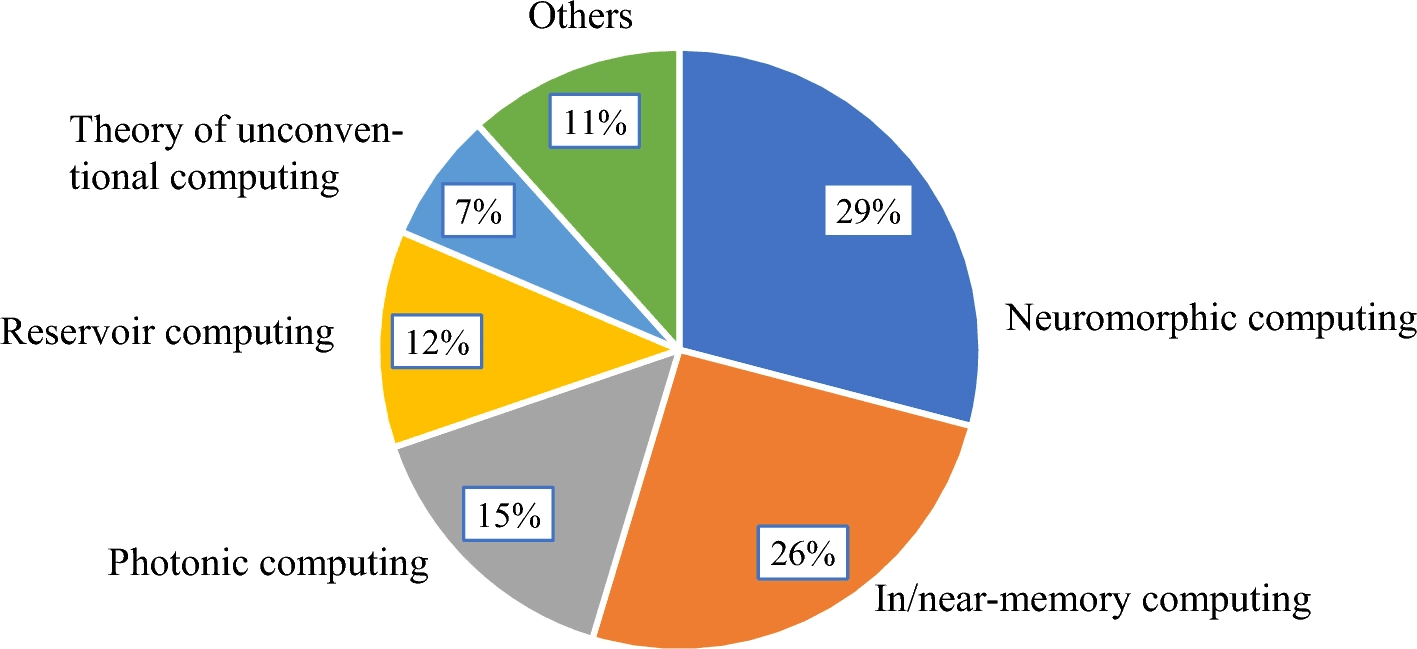
(Source: media.springernature.com)
- The above review shows neuromorphic computing holds the largest share of studied approaches, accounting for 29%.
- In/near-memory computing follows with 26%, while photonic computing accounts for 15%.
- Reservoir computing accounts for 12%, and the theory of unconventional computing accounts for 7%.
- The remaining 11% falls under other brain-inspired computing methods.
Conclusion
To sum up, the numbers on neuromorphic computing indicate that this field is growing rapidly and has a bright future. The increase in research, the development of new brain-like chips, and test results all reflect steady progress. The statistics indicate that these systems can use less energy, work faster, and learn better for some tasks.
Although some technical problems remain, the overall trend is positive. Neuromorphic computing is likely to help create more efficient AI, smarter small devices, and new kinds of applications.
FAQ.
We need neuromorphic computers for faster, low-power, brain-like processing in AI, robotics, and smart devices.
Neuromorphic computing can power robots, smart sensors, medical devices, autonomous cars, and low-power AI gadgets.
hey use special chips built with artificial neurons and synapses, called spiking neural networks or neuromorphic processors.
Low energy use, fast real-time responses, robust to noise, supports on-chip learning, and suits edge devices needing efficient intelligent processing
Complex hardware design, difficult programming, limited tools, compatibility with existing systems, and a lack of standard models today.

Maitrayee Dey has a background in Electrical Engineering and has worked in various technical roles before transitioning to writing. Specializing in technology and Artificial Intelligence, she has served as an Academic Research Analyst and Freelance Writer, particularly focusing on education and healthcare in Australia. Maitrayee's lifelong passions for writing and painting led her to pursue a full-time writing career. She is also the creator of a cooking YouTube channel, where she shares her culinary adventures. At Smartphone Thoughts, Maitrayee brings her expertise in technology to provide in-depth smartphone reviews and app-related statistics, making complex topics easy to understand for all readers.


